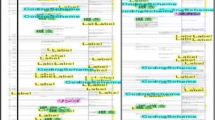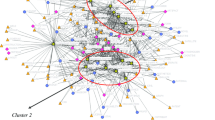Abstract
Empirical studies of material artifacts in practice continue to be a rich source of theoretical concepts for CSCW. This paper explores the foundational concept of boundary objects and questions the conception that all objects that move between communities of practice are boundary objects. This research presents the results of a year-long ethnographic study of collaborative work, specifically the multidisciplinary collaborative design of a museum exhibition. I suggest that artifacts can serve to establish and destabilize protocols themselves and that artifacts can be used to push boundaries rather than merely sailing across them. Artifacts used for collaboration do not necessarily exist within a web of standardized processes and disorderly processes should not be treated as “special cases”.








Similar content being viewed by others
References
Albrechtsen H., Jacob E.K. (1998). The Dynamics of Classification Systems as Boundary Objects for Cooperation in the Electronic Library. Library Trends 47(2): 293–312
Bechky B.A. (1999). Crossing Occupational Boundaries: Communication and Learning On a Production Floor. Industrial Engineering. Stanford University, Palo Alto, p 114
Bertelsen, O.W. and S. Bødker (2002): Interaction Through Clusters of Artefacts. In 11th European Conference on Cognitive Ergonomics (ECCE–11), Catania, Italy
Boujut J.-F., Blanco E. (2003). Intermediary Objects as a Means to Foster Co-operation in Engineering Design. Computer Supported Cooperative Work: The Journal of Collaborative Computing 12: 205–219
Bowker G.C., Star S.L. (1999). Sorting Things Out: Classification and Its Consequences. The MIT Press, Cambridge, MA
Brereton, M. and B. McGarry (2000): An Observational Study of How Objects Support Engineering Design Thinking and Communication: Implications for the Design of Tangible Media. CHI
Bucciarelli L. (1994). Designing Engineers. MIT Press, Cambridge, MA
Callon, M. (1985): Some Elements of a Sociology of Translation: Domestication of the Scallops and the Fishermen of St. Brieuc Bay. Power, Action and Belief, Sociological Review Monograph. Journal of Law, Vol. 32. London: Routledge & Kegan Paul, pp. 196–230
Diggins T., Tolmie P. (2003). The ‘Adequate’ Design of Ethnographic Outputs for Practice: Some Explorations of the Characteristics of Design Resources. Personal and Ubiquitous Computing 7(July): 147–158
Eckert C. (2001). The Communication Bottleneck in Knitwear Design: Analysis and Computing Solutions. Computer Supported Cooperative Work: The Journal of Collaborative Computing 10(1): 29–74
Garrety K., Badham R. (2000). The Politics of Socio-technical Intervention: An Interactionist View. Technology Analysis & Strategic Management 12(1): 103–118
Harper, R. (1998): Inside the IMF: An Ethnography of Documents, Technology and Organizational Action. Academic Press
Heath C., Luff P. (1996). Documents and Professional Practice: ‘Bad’ Organizational Reasons for ‘Good’ Clinical Records. ACM, CSCW, Boston, MA
Henderson K. (1999). On Line and On Paper: Visual Representations, Visual Culture, and Computer Graphics in Design Engineering. MIT Press, Cambridge, MA
Hertzum M. (1999). Six Roles of Documents in Professionals’ Work. ECSCW, Copenhagen, Denmark
Karsten H., Lyytinen K., et al. (2001). Crossing Boundaries and Conscripting Participation: Representing and Integrating Knowledge in a Paper Machinery Project. European Journal of Information Systems 10(2): 89–98
Krasner H., Curtis B., et al. (1987). Communication Breakdowns and Boundary Spanning Activities on Large Programming Projects. In: Olson G.M., Shepard S., Soloway E. (eds) Empirical Studies of Programmers: Second Workshop. Ablex, Norwood, NJ, pp. 47–64
Larsson, A. (2003). Making Sense of Collaboration: The Challenge of Thinking Together in Global Design Teams, GROUP ’03. Sanibel Island, FL: ACM
Latour B. (1987). Science in Action. Harvard University Press, Cambridge, MA
Law J. (1987) Technology, Closure and Heterogeneous Engineering: The Case of the Portuguese Expansion. In: Bijker W., Pinch T., Hughes T.P. (eds) The Social Construction of Technological Systems. MIT Press, Cambridge, MA, pp. 111–134
Lee, C. (2004): The Role of Boundary Negotiating Artifacts in the Collaborative Design of a Museum Exhibition. Ph.D. Dissertation, Department of Information Studies. Los Angeles, University of California, Los Angeles: 299
Lutters, W.G. and M.S. Ackerman (2002): Achieving Safety: A Field Study of Boundary Objects in Aircraft Technical Support. Computer Supported Cooperative Work, CSCW 2002, New Orleans, Louisiana, USA: The Association for Computing Machinery (ACM)
Mambrey, P. and M. Robinson (1997): Understanding the Role of Documents in a Hierarchical Flow of Work. Group 97, Phoenix, AZ: ACM
Pawlowski, S.D. and D. Robey et al. (2000): Supporting Shared Information Systems: Boundary Objects, Communities, and Brokering. Twenty First International Conference on Information Systems. Atlanta, GA: Association for Information Systems
Perry M., Sanderson D. (1998). Coordinating Joint Design Work: the Role of Communication and Artefacts. Design Studies 19(3): 273–288
Pycock J., Bowers J. (1996). Getting Others to Get it Right: An Ethnography of Design Work in the Fashion Industry. CSCW, Boston Massachusetts
Schmidt K., Simone C. (1996). Coordination Mechanisms: Towards a Conceptual Foundation of CSCW Systems Design. Computer Supported Cooperative Work: The Journal of Collaborative Computing 5(2–3): 155–200
Schmidt K., Wagner I. (2002). Coordinative Artifacts in Architectural Practice. In: Blay-Fornarino M., Pinna-Dery A.M., Schmidt K., Wagner I. (eds) Cooperative Systems Design. A Challenge of the Mobility Age. IOS Press, Amsterdam, The Netherlands, pp 257–274
Schmidt K., Wagner I. (2005). Ordering Systems: Coordinative Practices and Artifacts in Architectural Design and Planning. Computer Supported Cooperative Work: The Journal of Collaborative Computing 13: 349–408
Sonnenwald D.H. (1995). Contested Collaboration: A Descriptive Model of Intergroup Communication in Information System Design. Information Processing & Management 31(6): 859–877
Star S.L. (1987–1989). The Structure of Ill-Structured Solutions: Boundary Objects and Heterogeneous Distributed Problem Solving. In: Gasser L., Huhns M.N. (eds) Distributed Artificial Intelligence, Vol. II. Morgan Kaufmann, San Mateo, CA, pp 37–54
Star S.L., Griesemer J.R. (1989). Institutional Ecology, ‘Translations’ and Boundary Objects: Amateurs and Professionals in Berkeley’s Museum of Vertebrate Zoology, 1907–39. Social Studies of Science 19: 387–420
Strauss A. (1988). The Articulation of Project Work: An Organizational Process. The Sociological Quarterly 29(2): 163–178
Subrahmanian E., Monarch I., et al. (2003) Boundary Objects and Prototypes at the Interfaces of Engineering Design. Computer Supported Cooperative Work: The Journal of Collaborative Computing 12: 185–203
Tang J.C. (1989). Toward an Understanding of the Use of Shared Workspaces by Design Teams. Department of Mechanical Engineering. Stanford University, Stanford, CA
Van House, N.A., M.H. Butler, et al. (1998): Cooperative Knowledge Work and Practices of Trust: Sharing Environmental Planning Data Sets. CSCW 98. Seattle, Washington: ACM
Wenger E. (1998). Communities of Practice. Cambridge University Press, New York, NY
Acknowledgements
This work has benefited from the assistance of Leah Lievrouw, Jonathan Furner, Jennifer A. Rode, the reviewers of this manuscript, and especially Phil Agre and Paul Dourish. This work has been funded in part by NIH grant #5M01RR000827 and a postdoctoral fellowship from the California Institute for Telecommunications and Information Technology (Calit2) at UC Irvine.
Author information
Authors and Affiliations
Corresponding author
Additional information
An earlier draft of the work was published in the Proceedings of the 9th European Conference on Computer Supported Cooperative Work (ECSCW 2005). Several pages longer, this work adds substantial clarification of the theoretical critique and also includes photographs of actual case study artifacts.
Rights and permissions
About this article
Cite this article
Lee, C.P. Boundary Negotiating Artifacts: Unbinding the Routine of Boundary Objects and Embracing Chaos in Collaborative Work. Comput Supported Coop Work 16, 307–339 (2007). https://doi.org/10.1007/s10606-007-9044-5
Received:
Accepted:
Published:
Issue Date:
DOI: https://doi.org/10.1007/s10606-007-9044-5




